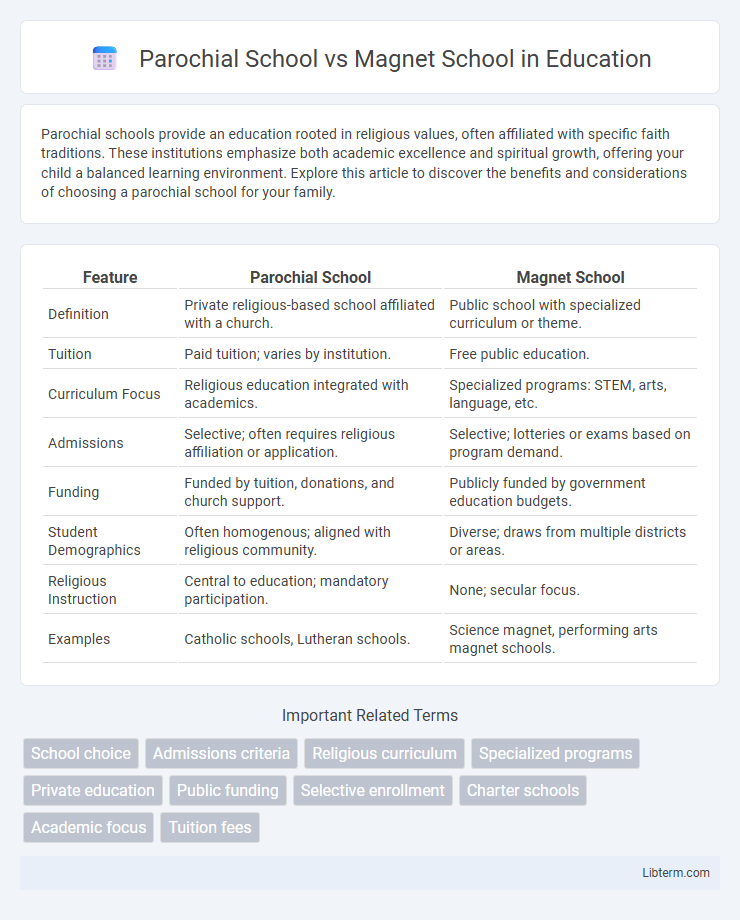Parochial schools provide an education rooted in religious values, often affiliated with specific faith traditions. These institutions emphasize both academic excellence and spiritual growth, offering your child a balanced learning environment. Explore this article to discover the benefits and considerations of choosing a parochial school for your family.
Table of Comparison
| Feature | Parochial School | Magnet School |
|---|---|---|
| Definition | Private religious-based school affiliated with a church. | Public school with specialized curriculum or theme. |
| Tuition | Paid tuition; varies by institution. | Free public education. |
| Curriculum Focus | Religious education integrated with academics. | Specialized programs: STEM, arts, language, etc. |
| Admissions | Selective; often requires religious affiliation or application. | Selective; lotteries or exams based on program demand. |
| Funding | Funded by tuition, donations, and church support. | Publicly funded by government education budgets. |
| Student Demographics | Often homogenous; aligned with religious community. | Diverse; draws from multiple districts or areas. |
| Religious Instruction | Central to education; mandatory participation. | None; secular focus. |
| Examples | Catholic schools, Lutheran schools. | Science magnet, performing arts magnet schools. |
Introduction to Parochial and Magnet Schools
Parochial schools are private educational institutions typically affiliated with religious organizations, offering a curriculum that integrates faith-based teachings with standard academics. Magnet schools, publicly funded and specialized, provide focused programs in areas such as STEM, arts, or language immersion to attract a diverse student body from multiple districts. Both school types emphasize unique educational approaches aimed at enhancing student engagement and learning outcomes.
Historical Background and Origins
Parochial schools originated in the early 19th century, established primarily by religious organizations to provide faith-based education alongside standard curricula. Magnet schools emerged in the 1960s as part of desegregation efforts, designed to offer specialized programs in science, arts, or technology to attract a diverse student population. Both school types reflect distinct historical responses to community educational needs and social challenges.
Admission Processes Compared
Parochial schools typically require admission based on religious affiliation, demonstrated commitment to faith, and sometimes entrance exams or interviews aligned with their religious values. Magnet schools implement competitive admission processes emphasizing academic performance, standardized test scores, and targeted selection criteria for specialized programs such as STEM, arts, or language immersion. Both systems may also consider geographic zoning, but magnet schools prioritize diversity and talent matching, while parochial schools focus on faith-based community integration.
Curriculum Differences
Parochial schools emphasize religious-based curriculum alongside standard subjects, integrating faith and moral education daily. Magnet schools offer specialized academic programs focused on STEM, arts, or languages, designed to foster advanced skills and innovation. Curriculum in parochial schools centers on spiritual development, while magnet schools prioritize thematic expertise and accelerated learning.
Academic Performance and Outcomes
Parochial schools often emphasize rigorous academic curricula combined with religious education, resulting in higher standardized test scores and graduation rates compared to public schools. Magnet schools focus on specialized programs like STEM or arts, attracting motivated students and demonstrating strong academic outcomes, particularly in advanced coursework and college readiness. Both school types typically outperform traditional public schools in academic performance and post-secondary success metrics.
School Culture and Community
Parochial schools emphasize a faith-based school culture fostering strong community bonds through shared religious values and traditions, creating a closely-knit environment centered on spiritual development. Magnet schools cultivate diverse, specialized academic communities, attracting students with common interests and talents, which encourages collaboration and innovation across varied cultural and intellectual backgrounds. Both schools prioritize supportive environments but differ significantly in their cultural focus, with parochial schools integrating religion into daily life while magnet schools emphasize academic specialization and diversity.
Extracurricular Opportunities
Parochial schools often provide extracurricular opportunities rooted in religious values, such as faith-based service clubs and spiritual retreats, fostering character development alongside academics. Magnet schools emphasize specialized programs in arts, science, or technology, offering extracurricular activities like robotics clubs, advanced performing arts ensembles, and STEM competitions that align with their academic focus. Both school types encourage student engagement beyond the classroom, but magnet schools typically present a broader range of specialized extracurricular options tied to their curricular themes.
Cost and Funding Structures
Parochial schools primarily rely on tuition fees paid by families and financial support from religious organizations, which can make costs higher but often include scholarships or parish subsidies to reduce the burden. Magnet schools are publicly funded through government resources, making them tuition-free for students, with costs covered by local, state, and federal education budgets. The contrast in funding structures results in parochial schools generally having higher direct costs for families, whereas magnet schools provide specialized curricula without tuition fees due to public funding.
Parental Involvement and Expectations
Parochial schools often emphasize strong parental involvement through religious community engagement and frequent communication between families and educators, fostering shared values and accountability. Magnet schools typically encourage parental participation by promoting specialized academic programs and offering opportunities for parents to support their child's interests and talents. Expectations in parochial schools tend to align with moral and religious development alongside academics, while magnet schools focus on high academic achievement and skill specialization.
Choosing the Right Fit for Your Child
Selecting between parochial schools and magnet schools hinges on understanding your child's educational needs, learning style, and values. Parochial schools offer faith-based education with a strong emphasis on moral development and community, while magnet schools provide specialized curricula focused on STEM, arts, or language immersion that cater to specific talents. Evaluating academic programs, extracurricular opportunities, and school culture ensures alignment with your child's strengths and aspirations for optimal growth.
Parochial School Infographic

 libterm.com
libterm.com